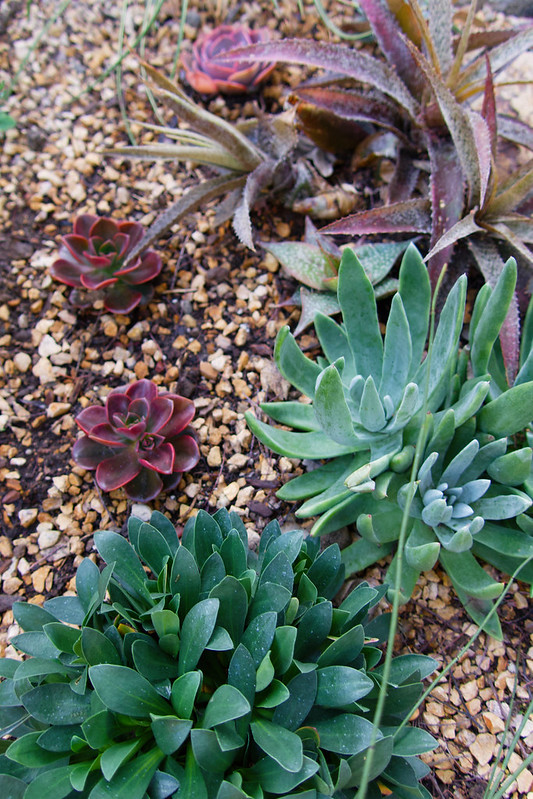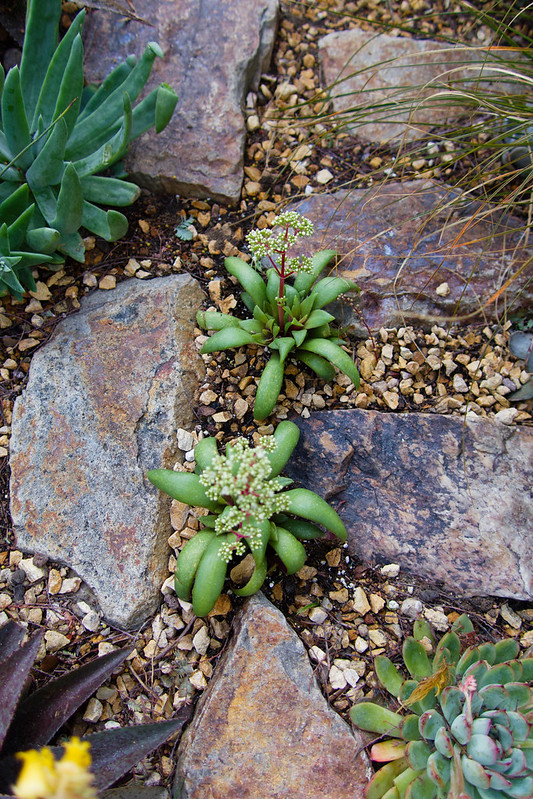The poppies self-sown into the new gravel area have grown so tall I wasn’t sure if they were my old standbys, the smaller statured Papaver setigerum. Blooms opening this week confirmed that indeed they are, but just gaining a bit more size in this slightly mounded area topped with crushed rock. There seem to be some true somniferum seedlings here too, which are much larger plants with “leafier” leaves. I’m hoping it’s ‘Lauren’s Grape.’ If not I’ll probably pull the plant and let the Poppies of Troy/P. setigerum have reseeding honors here. This gravel area has been a hotbed of seed activity — Geranium maderense* seedlings have turned up, a plant that hasn’t flowered here for years, the annual variegated Polygonum orientalis, and a single ballota seedling has appeared which I’m hoping will thrive and reintroduce this great plant to the new gravel area.
(*Now that the first set of true leaves has grown in, I can see these are not Geranium maderense but most likely seedlings of a mediterranean brassica, Brassica cretica subsp. aegaea whose seed I threw in this area.)
Passiflora vitifolia opened its first blooms this week as well — and I’ve already found a seedling from this vine in its second (third?) year in the garden. Finding seedlings is my kind of treasure hunt — unless I’m overrun with sheets of them from plants like labrador violets or Tinantia pringlei. Erodium triflorum (formerly pelargoniflorum) reseeds fairly lustily too, and is confined to the very dry front garden to bite the ankles of the big succulents there like Aloe ‘Hercules,’ Agave ‘Jaws,’ Fucraea macdougalii…(ankle biters are on my mind now with the arrival of a new puppy Billie…sshhh, mercifully she’s sleeping now. I’ll properly introduce her very soon.)
With the March winds unabating, I decided to stake the sonchus. Having produced a second year of blooms, and even thrown a few seedlings, I don’t want to take any chances now that it looks to have a reasonable chance of becoming a garden mainstay. A couple of seedlings were potted and a few left in situ. I’d like more this year, please! The sonchus was moved against the back wall, in the assumption that its appearance would deteriorate as summer progresses like its brethren S. canariensis, which is strongly summer dormant and loses its leaves. Such a shabby performance is hard on the eyes in a small garden. S. palmensis thins out leaves as well but last summer managed to keep enough leaves to remain presentable. I’m glad I moved it in any case, because it seems to love the alternating strong and dappled sunlight at the edge of the canopy of the fernleaf acacia. (No photos taken yet, but I also staked the enormous flowering tobacco, Nicotiana mutabilis, and the groundsel Roldana petasites, which were battered and leaning from the winds. The roldana’s inflorescence is very similar in appearance to the sonchus.)
New echeverias are still finding their way into the rock spur area. Above is E. ‘Burgundy Pearl.’ The dudleya hasn’t bloomed yet so I’m unsure of its identity. The leaves look like Dudleya brittonii, but we’ll see what the blooms show.
Another recent addition, I like how this crassula extends the dudleya vibe with linear leaves. Nice burgundy stems and foaming flowers — Crassula orbicularis var. rosularis.
The large-leaved Stachys ‘Big Ears’ appeared locally, so I grabbed a couple because I was thinking of mail-ordering some anyway, along with compact Dianella ‘Baby Bliss’ to flank Mangave ‘Lavendar Lady’ — filling the ground vacated by moving out the blooming Agave ‘Dragon Toes.’ The now uprooted agave’s flowers buds are swelling and, fingers crossed, getting ready to open.
Fall/winter/spring is such a great time for aeoniums, but through renovations and plant shuffling and just taking my eye off the ball, the garden has a very light aeonium presence this year. I’d forgotten about this clump in a mix of succulents just off the back porch, which has been quietly building size until finally making its spring presence dramatically known by illumination. An Aloe ‘David Verity’ is in danger of being crushed by the saucers, so their days basking in the sunshine here may be numbered as well.
And I want to thank John Palmer for his comment regarding the giant fennel: “It is Ferula communis and it most certainly is not monocarpic in Cyprus. I have been here for 15 years now and witnessed them at the roadside in abundance, getting bigger and bigger each year in the same locations. I collected and sowed seeds 3 years ago and raised over 30 young plants some of which are flowering for the first time right now at about 2′ (600mm) high. I only recently discovered that it was not a wild form of Foeniculum (real Fennel) which is just as well as we were considering drying the foliage and feeding it to our horses – turns out it can be toxic!”
My two plants are alive and leafing out — whether they ever flower here is still an open question.
Did you catch the NYT remarking on the surge in popularity of Gardener’s World? (“How a British Gardening Show Got People Through the Pandemic.) I’d read one of host Monty Don’s books years ago (“The Jewel Garden”?) that covered his early jewelry making venture and subsequent depression when that business was upended by a UK financial crisis, but I’d never sought out the show. I’m still a recovering anglophile when it comes to plants and gardens, so I usually opt to save myself the heartache of viewing enormous drifts of complicated seasonal planting rinsed in rain in summer, with the off seasons spent puttering in the greenhouse and planning fresh challenges for the acreage. Spring ephemerals, thalictrum, sanguisorba — that orderly, predictable progression of genera throughout the seasons backed by centuries of plant exploration and experimentation and intense garden culture, I admit I have envied these things so I stayed away from Gardener’s World. But like all those other pandemic viewers, finally I succumbed. Just in the past few weeks, right before the article appeared, I streamed some episodes. And while I think my garden anglophilia recovery is still on solid ground, I completely get this series’ popularity. Plants, bird song, dogs (Nigel!), the mesmerizing sound of shovels sinking into soil, visits to extraordinary gardens — no matter where or how big your garden, or whatever your prejudices (!), it’s a strong antidote to what ails us now. The readers’ rapturous comments, many by non-gardeners and those lacking even a balcony, are as the Brits say, just lovely.
Margaret Roach’s report on specialty nurseries in the NYT is likewise a treat: “Why Shop at a Specialty Nursery?” Here’s to more intelligent garden journalism in U.S. publications! That’s how a garden culture grows…










So many wonderful sights and surprises. I love the sonchus inflorescence. I’ve never been able to keep it alive for long here in Davis–it’s too hot in the summer.
I staked my Roldana petasites just this past Saturday! Now the leaves are all pointing the wrong way. I hope they’ll right themselves.
And my giant fennel is back, too! I’m so happy.
Gerhard, your roldana looks even taller than mine! I’m going to cut it back after bloom to encourage more basal growth. It would be so cool if one of the fennels in either of our gardens bloomed!
Hard to imagine now it came out of a 4″ pot from Annie’s Annuals!
I’d love more basal growth, too!
No reason the fennel shouldn’t bloom, but maybe it’s a matter of age and size?
I love your clippings posts, Denise. I continue to marvel at your success with poppies when they fail me more often than not. Your photos of the Sonchus will have me taking another look at where I can possibly place that plant. The Crassula has been one of my favorites since I discovered it a couple of years ago. Re Gardeners’ world, I fell prey to its allure a few years ago and last night was happy to discover episode 1 for the 2021 season was available on YouTube. As to Billie, I look forward to a proper introduction. PBS NewsHour just reported that today is National Puppy Day so get cracking on that post!
I was instantly attracted to the form of your Alcantarea odorata – but unfamiliar with the plant. It seems to be thriving in the ground. Has it ever suffered from inclement weather at your place?
Your description of what make Gardener’s World such a treat is spot on. The American gardening shows just don’t come close to their British counterparts. I often wonder why. I think part of the reason is the British TV hosts are gardeners first and foremost who happen to also be presenters. In America everyone on a TV show (or perhaps even in media more broadly) looks as if they stepped off a Soap Opera or has a career in modeling. Familiarity (or a passion for) the subject in question seems less important. A US program like “This Old House” is about as close as I’ve seen us come to matching what’s on the BBC.
@Kris, I think the sonchus might love some of your slopes if not too shady. Yes, must get a Billie report up soon!
@Hans, yes, the alcantarea is in the ground and gets a good deal of sun. The only inclement weather I can think of to harm it might be frost, and we’ve had frost maybe once in the last 30 years, before the alcantarea was planted. You’re right about This Old House, lots of googling of their expertise for our old house!
Passiflora vitifolia, *sigh*…
Yes, I read that Monty column in NYT . I’ve been watching him for a few years now (all pirated YouTube stuff) and I find the episodes quite soothing. Who has a voice like that? Maybe Richard Burton comes to mind. In any case I too have a dog-eared copy of ‘The Jewel Garden’ that I have read over and over. I await our intro to Billie. Holiday?